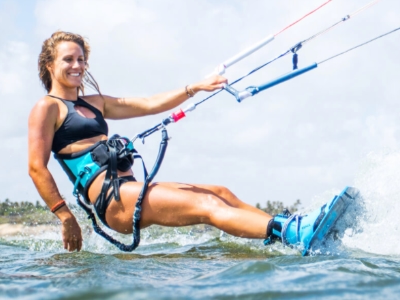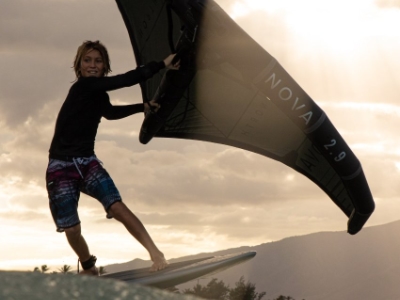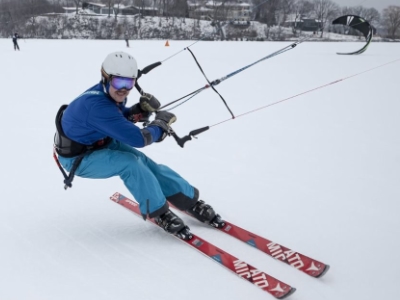TECHNICAL ASPECTS OF WINDSURFING GEAR
Types of Board Construction
Materials:
- Plastic = Shell over foam core – Rotomolded e.g. Tiga, OBrien, HiFly.
- Polyester = a.k.a "glass" - Fiberglass wrap over foam core using Polyester resin.
- Epoxy (refered to as "Custom") = Fiberglass over foam core using Epoxy resin & carbon stringers e.g. Gorge Animal, Petty, Seatrend, Open Ocean, Roberts, Logosz, Clam.
- Epoxy (semi-custom) = These are Epoxy boards which are made in a mold using heat & pressure which bonds the laysers together forming a seam along the side. These boards are also coated on the outside with a thin plastice shell called ASA (Alternative Skin) e.g. Mistral, F2, Bic.
Advantages/Disadvantages
1. Plastic Boards can with stand a lot of abuse, least expensive/ Heavier & slower to respond.
2. Polyester "glass" - can take moderater abuse, lighter than plastic, more responsive, and can be fixed easily at home by average person/ Heavier & more flexible than epoxy, yet lighter and stiffer than plastic.
3. Epoxy - Lighter & stiffer hence quicker to plane & respond, greater speed potential. Easier to lift off when jumping./ The least impact resistant of the 3 types & also more expensive. Not as easy to repair.
**General note - in Windsurfing "lighter" = more expensive.
4. Semi-custom production Epoxy – Good shapes, upper priced, yet not as expensive as custom Epoxy. Light & quick and more impact resistant than custom epoxy due to the ASA Skin./ More expensive than polyester or plastic boards. Not as easy to repair.
Shapes:
Length - Size of the board Tip to Tail, usually in feet & in cm. e.g. 8’6″ = 263cm
Width - How wide the board is, measured at “Beam” (mast track) & “Tail” (end of board)
Weight - Overall weight of board (with rider & rig weight) acts against the volume.
Volume - "Amount of floatation", amount of foam core contained inside shell.
Rocker line - Amount of lift from tail to tip
Rail tuck - Shape of "rail"(side of board) in relation to the boards bottom
What does it all mean? Bigger boards = Lighter winds, heavier riders, less expensive Smaller boards = Stronger winds, smaller riders, more expensive More volume = more flotation Width = A wider board has a more stable riding platform, and is more likely to be a wave board. Rocker line = When a board has more rocker or “nose kick” it is more of a bump & jump or wave oriented board and less race oriented. On these boards the displacement of volume will be more “aft” on the board. Rail Tuck = The harder the 90 degree angle on bottom rail of the board, the more race oriented the board is. The softer or more rounded the angle, the more bump & jump and wave oriented the board is. The softer the rail is the more foot responsive “tourney” or “looser”. The harder the rail the greater ability for tracking or “holding the line”. Bottom shape = Flatter bottoms are more speed or race oriented. V-shapes are more stable in rougher waters
Sail Types
1. Wave 2. Bump & Jump / Freeride 3. Slalom 4. Race
Sail Parts:
Luff sleeve (sock) - Sleeve the mast runs up, forward edge of sail luff panel – next panel from luff sleeve transition to monofilm
Head - Top section of sail
Foot - Bottom section of sail
Clew - Outer corner of sail
Leach - Tracking (loose) edge of sail
Batten - Epoxy or carbon “stays” – running across sail giving it support
Camber – A preformed component attaching battens to mast giving the sail a more stable draftWave sail design: There are no cambers – the sail can move easily, rotate & be manipulated when changing direction (jibing & tacking) quickly. The angle of the foot to the clew is a “higher” cut than on slalom or race sails. In other words you have less foot. To make up for this you usually have more area above the boom especially in the head so that the wave is not effectively blocking your wind. You also don’t want a lot of foot because it’s wasted material- down low. You don’t “rake” the sail back as you do when slalom or race sailing. In wave sailing you sail the rig more upright. Having a higher angle also makes it easier to perform tricks without having the foot material get in the way. Wave sails are rigged flatter than slalom or race sails and have a less effective wind range. There is usually a half a meter between sail sizes e.g. 3.0, 3.5, 4.0. Some sail designers make wave sails for specific conditions i.e. on-shore designs, side-shore designs, etc…
Race sail design: The luff sleeve is wider creating more draft stability. There are more battens which create more lateral stability. There are also numerous cambers (3,4, or even more) which create even more draft stability by effectively attaching the battens to the mast. Race sails are actually like a wing or foil, the shape is locked in. The head of a race sail is smaller in relationship to the foot than a wave sail. The head being smaller is good in a race sail because the sail is so draft stable that when the wind hits the sail it’s pressure creates lift (push) up to a point, then the excess effectively “bleeds” or “spills” off the leech (trailing edge of the sail). This is enhanced by the sail (via the mast) twisting at the head. The wind hits the sail moving up it and off the leech. The twist occurs because the head is small and in comparison the most flexible section of the sail. The more downhaul you put on the sail the more your are bending the mast and thus making the leash loose or floppy effectively creating a "pre-twisted off" condition. The head and leech at this point are going to create even less resistance to the wind. Outhauling more will flatten out the sail taking out the draft or shape. Doing this decreases the effective wind range of the sail. The race sail gets raked back. The larger foot closes the gap between the board & foil (again helping stability and efficiency). Race sails have great wind range because of the draft stability, the large foot and the ability to effectively “bleed” excess wind by "twisting off". The wind range is wider in each sail size than it is in a wave or bump&jump sail. In race sails you can usually space at every meter e.g. 5.0, 6.0, 7.0Bump’n’jump sail design: An all around sail style. They are often referred to as freeride and are easy to handle. They are designed to get the sailor on a plane quickly and have more low end power than a wave sail design.
Slalom sail design: Similar to a race sail these sails are quick to plane. There is not as much stability as a race sail but slalom sails are much more user friendly. The luff sock is smaller so no water gets trapped making it easier to waterstart. There are usually only two cambers in slalom sails.
Fin Information
Length & Width = Surface area
Surface area corresponds with sail size i.e. bigger sail = bigger fin More surface area creates greater lift.
Shapes:
Wave Wave – Bump & Jump Freeride, Convertible, Teardrop Blade, Pointer, Elliptical
The more swept back (from the leading edge) the fin is, (also known as the “amount of Rake”) the looser or more tourney the fin is. This creates more responsiveness to changes in the rider’s foot pressure. The longer straighter fin can create great amount of lift (like a dagger board) and are great for going up wind (into the wind). This is also called “trackablity” i.e. “the long blade fin tracks well…”. They do not respond to subtle shifts in foot pressure as well as wave fins do. If a sail is too big compared to the fin size, it will cause the board to slide or “spin out”. If the fin is too big the board will lift up out of the water. Any fin can spin out, there are a lot of factors, however, that can help keep you from doing so. All fins have a low pressure (vacuum) side and a high pressure side when you are sailing. As you apply more pressure to the fin with your back foot, you increase the vacuum pressure on the upwind side of the fin. This provides an opportunity for air from the atmosphere to get sucked towards and become attached to the low pressure side of the fin from the tail of the board, and thus causing you to spin out. To help keep you from spinning out, there are a few things that you might try: SLICE THE WATER WHEN LANDING When jumping (or even getting your board out of the water 1 inch) you provide a path for the air to travel to your fin. In order to close this path, you need to bear off (turn downwind) in the air, so that when you land, your fin slices through the water, and eliminates the opportunity of the air to reach your fin. After your board is back covering the water, you can redirect your board. ABSORB THE BUMPS Another helpful hint is to bend your back leg a bit to help absorb the chop, and keep your board covering the surface of the water. Bending your back left also puts a bit more downward pressure on the back of the board, and also helps keep the air channel closed. MOVE YOUR FIN FORWARD Moving your fin a bit forward, and away from the tail (where the air comes in), helps. Also having a cutout on the back of your fin increases the distance from the tail to the back of the fin, yet doesn’t effect the center of resistance (effective location) of the fin. The concept of the flapper you may have read about for the tails of race boards is based on the principle of keeping the area behind the fin covered so air cant easily reach the fin. MOVE YOUR MAST BASE BACK Moving your mast base further back in the track will position your sail more upright (not tipped way back behind your board), and may reduce the pressure you put on your back foot. USE A SLOTTED FIN If all of these things fail, you can always use a slotted fin. A slotted fin forces water through out the slot and constantly clears the air off the low pressure side of the fin, and as a result, keeps you from spinning out. The disadvantage of slotted fins is drag. The blade fin you are using on your board is fairly “high strung”. This type of fin has a short chord length (length from front of back of the fin as the water travels), which has low drag, and provides a lot of lift (gets you upwind), but is a difficult fin to use in low speeds, and is hard to control at most speeds.
Mast Information
Indexed MCS Measurement For Masts
The INDEXED MCS measurement system was developed to compare stiffnesses between masts of different lengths. MCS numbers only mean a stiffer or softer mast when comparing masts of the same length. For example: compare the 430/25 and 460/25. Even though the 430 has the same MCS stiffness number (25), when a 30cm carbon base extension is added to reach the 460 length, the stiffness is actually softer than the 460/25. By indexing all masts to one length (465cm), it is possible to use the MCS concept and compare masts of different lengths. Indexed MCS uses some arithmetic to relate every mast stiffness to 465cm length for more precise relative stiffness numbers.
INDEXED MCS = OVERALL LENGTH CUBED DIVIDED BY MID POINT DEFLECTION X 465 SQUARED
Example: Compare a 430cm with a mid-point deflection of 172 and a 460cm with a mid-point deflection of 184.
MAST LENGTH OLD MCS INDEXED MCS 430cm Mast 25 21 460cm Mast 25 25
KITESURFING WING-SURFING
FOILING
SNOWKITING
SUMMER & WINTER LESSONS
Stay informed with our specials and local news.Follow us on social media @lakawamn
LAKAWA FREQUENTLY ASKED QUESTIONS
Can anyone learn to kite?
Kiting can be learned by anyone in decent physical shape. With proper instruction and adherence to safety precautions anyone can fly and enjoy kiting. The sport offers many levels of extremes and how far you choose to push it will be up to you. Some prefer to cruise around in light winds very relaxed, others are pushing the envelope each time they go out, jumping higher, trying new tricks etc. It is important to find the path that feels comfortable for you. If you are uncertain, take the an Introductory course, we will supply the equipment and you decide if you like it. We are pretty certain, once you fly you will be hooked.
SUBSCRIBE TO NEWSLETTER
Be the first to hear about new equipment, classes, kiting camps and social events.
Also istay informed on related news.Follow us on social media @lakawamn
Book your wind sport lessons here!














